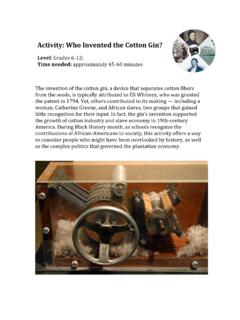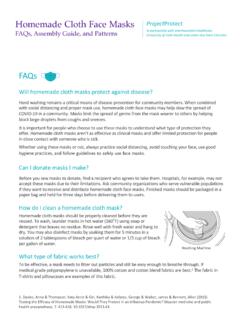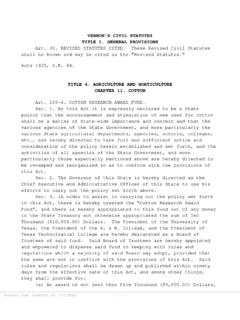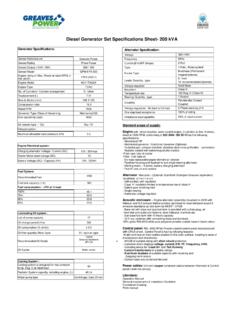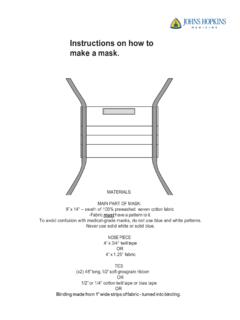Transcription of Classification of Cotton - Cotton Incorporated
1 CMYCMMYCYCMYK classing cover 1 9/17/2013 5:28:32 PMCotton Incorporated , funded by Cotton producers and importers of Cotton and Cotton textile products, conducts worldwide research and promotion activities to increase the demand for and profitability of Cotton . The Seal of Cotton is a registered trademark of Cotton Incorporated . AMERICA s Cotton PRODUCERS AND IMPORTERS. Service Marks/Trademarks of Cotton Incorporated . 2018 Cotton Classification of CottonCotton Council International s mission promotes exports of Cotton , cottonseed, and manufactured Cotton products through activities that affect every phase of the marketing chain. CCI operates in 50 markets under the Cotton USA banner.
2 The Cotton USA banner is a registered trademark of Cotton Council International. This booklet is produced by Cotton Incorporated with support from United States Department of Agriculture s Agricultural Marketing Service administers programs that facilitate the efficient, fair marketing of agricultural products, including food, fiber, and specialty crops. The USDA s Agricultural Marketing Service is the primary source of the information contained herein, based on The Classification of Cotton , Agricultural Handbook 566. This version of the handbook is produced by Cotton Incorporated with permission and assistance from USDA. The USDA Mark is a trademark of the United States Department of I.
3 Introduction ..1 II. Overview ..1 The Nature of Cotton ..1 Classification ..2 Structure ..3 Scope ..3 Process ..4 Tracking ..5 Overview of the Cotton Classification Process ..6 III. Maintaining Official Standards for Classification ..7 Grade Standards ..7 Instrument Standards ..8 Establishing Values for Calibration Cotton ..9 IV. Classification of Upland Cotton ..10 Fiber Length ..10 Length Uniformity ..10 Fiber Strength ..11 Micronaire ..12 Color Grade .. Grade ..15 Extraneous Matter ..16 Module Averaging ..16 V. Classification of American Pima Cotton ..17 VI. Quality and Reliability of Classification Data ..19 Laboratory Conditioning ..19 Sample Conditioning ..19 Equipment Performance Specifications.
4 20 Calibration of Instruments ..20 Quality Management Program ..21 VII. Dissemination of Data ..22 USDA Data Dissemination ..22 Cotton Incorporated s Cotton Resource Management Tools ..231I. IntroductionIn 1907, an international group of Cotton industry representatives met in Atlanta, Georgia, to address serious problems that had developed in the marketing of Cotton . A resolution was passed which recommended the establishment of uniform Cotton standards to eliminate price differences between markets, provide a means of settling disputes, make the farmer more cognizant of the value of his product, and, therefore, put him in a better bargaining position, and in general be of great benefit to the Cotton trade.
5 In response to this and similar calls for action over the next several years, laws were passed authorizing the United States Department of Agriculture (USDA) to develop Cotton grade standards and offer Cotton Classification services. Under the authority of the Cotton Statistics and Estimates Act of 1927, the Cotton Standards Act of 1923, and the Cotton Futures Act of 1914, USDA implemented a Classification system. Thus began an industry-government relationship that remains strong and viable to this day. This long-standing partnership demonstrates how government and industry can work together, each respectful of the other s role, to produce continuing beneficial results for the nation and for its customers OverviewThe Nature of CottonBotanically, three principal groups of Cotton are of commercial importance.
6 The first, the species Gossypium hirsutum, is native to Mexico and Central America and has been developed for extensive use in the United States, accounting for more than ninety-five percent of production. This group is known in the United States as American Upland Cotton and has fibers that range in length from about 7/8 to 15/16 inches. The second botanical group, the species G. barbadense, which makes up the balance of production, is of early South American origin. With fibers ranging in length from 1 inches to 19/16 inches, it is known in the United States as American Pima Cotton , also commonly referred to as Extra-Long Staple Cotton . A third group, G. herbaceum and G. arboreum, consists of cottons with shorter fiber lengths, to 1 inch, that are native to India and Eastern Asia.
7 No cottons from this group are grown in the United single pound of Cotton may contain 100 million or more individual fibers. Each fiber is an outgrowth of a single cell that develops in the surface layer of the Cotton seed. During early stages of its growth, the fiber elongates to its full length as a thin-walled tube. As it matures, the fiber wall is thickened by deposits of cellulose inside the tube, leaving a hollow area in the center. When the growth period ends and the living material dies, the fiber collapses and twists about its own term Cotton Classification in this publication refers to the application of official standards and standardized procedures developed by USDA for measuring those physical attributes of raw Cotton that affect the quality of the finished product and/or manufacturing efficiency.
8 USDA s classing methodology is based on both grade and instrument standards used hand-in-hand with state-of-the-art methods and equipment to provide the Cotton industry with the best possible information on Cotton quality for marketing and processing. USDA Classification currently consists of determinations of fiber length, length uniformity, fiber strength, micronaire, color, trash, leaf, and extraneous matter. USDA s classing methodology is based on both grade and instrument standards used hand-in-hand with state-of-the-art methods and system is rapidly moving from reliance on the human senses to the use of high-volume, precision instruments that perform quality measurements in a matter of seconds.
9 Only the classifications for extraneous matter and special conditions are still performed manually. Research and development continue for the technology and instrumentation to rapidly measure extraneous matter, as well as other important fiber characteristics, such as maturity, stickiness, short-fiber content, and neps. USDA will complete the transition to an all-instrument Classification as quickly as the technology can be developed and instruments are sufficiently refined to assure representative and reliable quality provides Cotton Classification services under the direction of the Agricultural Marketing Service (AMS) Cotton and Tobacco Program. The Program has eight main areas of operation: the Grading Division, the Standardization and Engineering Division, the Quality Assurance Division, the Market News Division, the Information Technology Division, the Research and Promotion Staff, the Administrative Staff, and the Program Appraisal Staff.
10 Each area of operation plays an integral role in maintaining a reliable, efficient, and effective Classification system and delivery of all Cotton grown in the United States is classed by USDA at the request of producers. Although Classification is not mandatory, growers generally find it essential to marketing their crop and for participation in the USDA price support program. The USDA AMS Cotton and Tobacco Program operates ten Cotton classing facilities across the Cotton Belt (their locations are shown on the map on the inside back cover of this booklet). These facilities, which are part of the USDA classers identify whether any extraneous matter is present. 4 Grading Division, are designed specifically for Cotton Classification and are staffed exclusively with USDA personnel.

